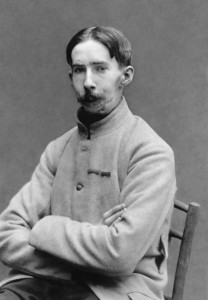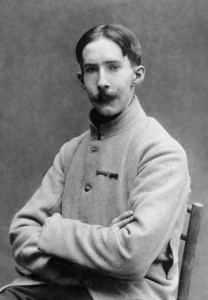by Jack El-Hai (Wonders & Marvels contributor)
With copper, foil, and paint, a little-known American sculptor saved scores of World War I soldiers from a faceless future.
In the final months of 1917, groups of wounded soldiers began arriving at an artist’s studio on Rue Notre-Dame-des-Champs in the Latin Quarter of Paris. Moving haltingly and sometimes guided by helpers, they entered a courtyard filled with statues, climbed five flights, and found themselves in a large room illuminated by tall windows and banks of skylights. Their host was an imposing American with high cheekbones and pinned-back hair, a 39-year-old Bostonian named Anna Coleman Ladd.
As the men laughed and smoked, Ladd examined them. She studied their shot-off jaws, missing noses, and scarred and empty eye sockets. Doctors could not restore these soldiers to handsomeness, or even to ordinariness. But as a sculptor, Ladd could apply talents that the doctors lacked. She could make new faces—masks—for the men, beautifully crafting them of copper, metallic foil, and paint. And wearing their prosthetic masks, the soldiers could return to the families, fiancées, and friends they had been afraid to allow in their unsightly presence.
The volunteer work of this intrepid artist has vanished from our memory of World War I. During the year and a half she spent directing the work of the Red Cross Studio for Portrait Masks—a division of the French Bureau for Reeducation of the Mutilated—Ladd saved nearly 100 French soldiers, as well as several of other nationalities and civilians, from the deep isolation of disfigurement.
Conceiving the prosthetic mask
Some months earlier, Francis Derwent Wood, an artist initially assigned to wash dishes in a London hospital, noticed the distress of facially mutilated British soldiers and decided to do something about it. He developed a technique of packing facial wounds with cotton wool, creating a plaster mask that fit the soldier’s skin, and then building a clay model of a healed face. Wood took a cast of the clay model and, using an electrotyping process, deposited on it a thin layer of silver. In the end, he had a lightweight and well-fitting metal mask that, when skillfully painted and attached with a ribbon or spectacles earpieces, hid the ugly wounds of battle and offered a more presentable face.
Not long after, Ladd made the Atlantic crossing herself. By November 1917 she had patrolled the front line hospitals for suitable patients and opened her own portrait mask studio in Paris. She intended to improve on Wood’s technique. Using photographs of the soldier taken before his injury, or working from verbal descriptions if no photo was available, she sculpted a close duplication of the man’s undamaged features on a plaster cast. From that, she produced a mask of gutta-percha, a natural latex collected from evergreen trees. Hanging this mask in a copper bath infused with electric current resulted in the creation of a thin, light, metallic mask that she painted with an enamel concoction of her own invention to match the soldier’s skin tone. “If the wounded man was blind, the mask would be equipped with artificial eyes,” Ladd told a reporter years later. “Eyelashes, eyebrows, and even mustaches were affixed in the masks. They were light and durable. The masks will last a lifetime.”
Masks restored hope
In 1932 the French government belatedly paid tribute to her war work by making her a Chevalier of the Legion of Honor—an award she received only because a French diplomat admired one of her sculptures on exhibit in Italy and decided to research her career. None of her masks seems to have survived to the present day; some may have been buried with their owners, and Ladd apparently destroyed others. Her modesty about her war work probably contributed to the quickness with which her accomplishments disappeared from memory. When she died in 1939 in Montecito, Calif., the public knew her as a minor sculptor if they knew her at all, but a handful of French soldiers realized that they owed her their happiness.
Further reading:
Alexander, Caroline. “Faces of War.” Smithsonian, February 2007.
Biernoff, Suzannah. “The Rhetoric of Disfigurement in First World War Britain.” Social History of Medicine, November 25, 2011.
Romm, Sharon and Judith Zacher. “Anna Coleman Ladd: Maker of Masks for the Facially Mutilated.” Plastic and Reconstructive Surgery 70, July 1982.
(This post was previously published in different form in The History Channel Magazine.)


